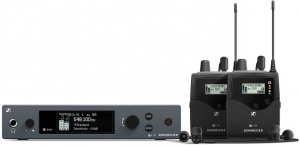In Ear Monitors for an L1 User
|
This article expresses my opinion and experience. Please post comments to Twitter @ST_Muso or LinkedIn @STPro. Thank you — ST. |
In-Ear Monitors for an L1 User?
I just got my In-Ear-Monitors. Sennheiser EW IEM G4 - Double Wireless In-Ear-Monitor-System
I normally run my PA (Bose L1 behind me). I don't have separate monitors. I wanted to try in-ear-monitors for a change.
First Time Setup
The Sennheiser system worked out of the box. I connected the headphone output of my T8S ToneMatch Mixer to the inputs of the transmitter to try things out quickly. I took time to get to learn the details after several hours of spontaneous fun.
First Impressions
- Guitar
The guitar through the Kemper Profiler sounds great through the in-ear-monitors, but to put that into context, I'm used to hearing it through my L1 Pro32. It's not massively different.
- Vocals
I usually run the vocals dry in the PA (no reverb or time-related effects) because there's usually plenty of natural reverberation in the room. That means the headphone mix is dry, too - drier than what I usually hear (voice in the room sound). That's okay. I don't mind.
It will take some time to get used to the occlusion effect (try singing with your fingers in your ears). The guitar sounds fine. My voice sounds funny. When I have more time, I'll set up a proper monitor mix to control the vocal and guitar levels separately.
I'll need to rehearse with the in-ear-monitors to get used to hearing myself that way. Don't get in-ear monitors and experience them for the first time at a gig. Get to know them first.
Later Impressions
Several hours later.
Wow - I wish I had gotten wireless in-ear-monitors sooner.
The best part is the wireless. Back when I had to consider the neighbours and cohabitants, I would occasionally play with headphones. I hated it - mostly because I play standing up and I wander around. Within minutes I was a tangled mess. You find out quickly if you tend to turn in one direction when there are cables involved. I went wireless for the guitar a long time ago, which made using headphones all the more vexing.
Remember the first time you played wireless with your guitar on stage? I got to relive that all over again with wireless monitoring.
I'm still getting used to the earbuds and the occlusion effect when I'm singing. When I want to give that a rest, I can use regular headphones that plug into the wireless receiver. My Bose NC 700 headphones work fine.
The initial setup was drop-dead simple, but there are plenty of options, including a limiter so I won't blow out my ears.
I have lots of wireless gear but this stands out from the rest. The belt-pack receiver has a clear, easy-to-read display. The construction feels solid (all metal) compared to all my other plastic belt packs.
Why In-Ear Monitors?
- I don't use monitors
I've been playing in front of my L1 systems since June 2004. On extremely shallow stages, I have had to stand beside my L1, but in all this time, I can't recall setting up a monitor for me. I have enjoyed the sound of the L1 behind me, and the sense of being in the same sound field as my audiences. I felt it was the responsible thing to do - being downstream from my output before subjecting my audiences to it.
- So why get In-Ear Monitors?
- The L1 Pro16 (118 dB SPL) and the L1 Pro32 (122 dB SPL) are both louder than the L1 Model II (115 dB SPL). I rarely played the L1 Model II at the maximum volume, but when I did, I wore ear protection. On those occasions, I thought about in-ear monitors. It's going to be tempting to go all out with the L1 Pro systems from time to time. I want to be prepared.
- Sometimes I have to set up remote loudspeakers. I can use the in-ear monitor system to do that.
- If it isn't convenient to set up the L1 for practice or rehearsal (e.g., playing at home or anywhere you might disturb others), in-ear monitors can give you the auditory experience of playing at gig volume.
Why UHF instead of 2.4 Mhz Digital
If you're wondering why I went with a UHF system instead of one of the less expensive 2.4 MHz systems - it's because the 2.4 MHz range is crowded. I don't want to get to a gig and find that all the available channels are occupied by the ubiquitous wireless guitar and microphone systems. I may be wrong, but I think we're going to see some problems when all those players who got 2.4 Mhz wireless systems while we were locked down, show up on stage together for the first time.
Why the Twin System
I got the package deal with two receivers for two reasons.
- The system is stereo, but you can split the signals and have two monitor mixes - one for each receiver. I necessary, I can use the system for two people.
- You can run remote loudspeakers for larger venues in stereo or dual mono. See Sennheiser EW IEM G4 for details
Related Material
Mixing Live Sound - IEMS & Monitors
